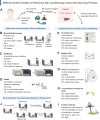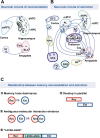How Fear Memory is Updated: From Reconsolidation to Extinction?
- PMID: 40205305
- PMCID: PMC12158906
- DOI: 10.1007/s12264-025-01367-7
How Fear Memory is Updated: From Reconsolidation to Extinction?
Abstract
Post-traumatic stress disorder (PTSD) is a psychiatric disorder caused by traumatic past experiences, rooted in the neurocircuits of fear memory formation. Memory processes include encoding, storing, and recalling to forgetting, suggesting the potential to erase fear memories through timely interventions. Conventional strategies such as medications or electroconvulsive therapy often fail to provide permanent relief and come with significant side-effects. This review explores how fear memory may be erased, particularly focusing on the mnemonic phases of reconsolidation and extinction. Reconsolidation strengthens memory, while extinction weakens it. Interfering with memory reconsolidation could diminish the fear response. Alternatively, the extinction of acquired memory could reduce the fear memory response. This review summarizes experimental animal models of PTSD, examines the nature and epidemiology of reconsolidation to extinction, and discusses current behavioral therapy aimed at transforming fear memories to treat PTSD. In sum, understanding how fear memory updates holds significant promise for PTSD treatment.
Keywords: Engram; Extinction; Fear memory; Post-traumatic stress disorder; Reconsolidation.
© 2025. The Author(s).
Conflict of interest statement
Conflict of interest: The authors declare that there are no conflicts of interest.
Figures




Similar articles
-
Reconsolidation/destabilization, extinction and forgetting of fear memory as therapeutic targets for PTSD.Psychopharmacology (Berl). 2019 Jan;236(1):49-57. doi: 10.1007/s00213-018-5086-2. Epub 2018 Oct 29. Psychopharmacology (Berl). 2019. PMID: 30374892 Free PMC article. Review.
-
Behavioral interventions to eliminate fear responses.Sci China Life Sci. 2018 Jun;61(6):625-632. doi: 10.1007/s11427-018-9294-4. Epub 2018 May 7. Sci China Life Sci. 2018. PMID: 29744783 Review.
-
Fear extinction and memory reconsolidation as critical components in behavioral treatment for posttraumatic stress disorder and potential augmentation of these processes.Neurosci Lett. 2017 May 10;649:170-175. doi: 10.1016/j.neulet.2017.01.006. Epub 2017 Jan 5. Neurosci Lett. 2017. PMID: 28065842 Review.
-
[Mechanisms of reconsolidation and extinction of fear memory].Nihon Shinkei Seishin Yakurigaku Zasshi. 2009 Jun;29(3):125-33. Nihon Shinkei Seishin Yakurigaku Zasshi. 2009. PMID: 19663263 Review. Japanese.
-
Reconsolidation and extinction: Using epigenetic signatures to challenge conventional wisdom.Neurobiol Learn Mem. 2017 Jul;142(Pt A):55-65. doi: 10.1016/j.nlm.2017.01.007. Epub 2017 Jan 21. Neurobiol Learn Mem. 2017. PMID: 28119018 Free PMC article. Review.
References
-
- Girgenti MJ, Wang J, Ji D, Cruz DA, Stein MB, et al. Transcriptomic organization of the human brain in post-traumatic stress disorder. Nat Neurosci 2021, 24: 24–33. - PubMed
Publication types
MeSH terms
LinkOut - more resources
Full Text Sources
Medical
Miscellaneous

